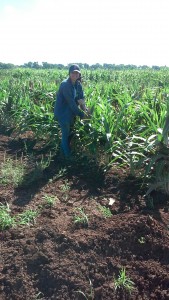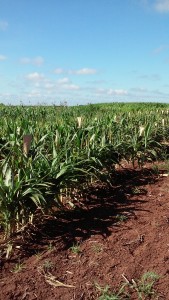One last project that I have taken part in these final two weeks of my internship is another experiment that is taking place in cooperation with the sorghum breeding program at A&M. This project is mostly being led by Blake and Dr. Rooney who is the sorghum breeder here at A&M. The project consists of using ESM which stands for Ethyl methanesulfonate which is a mutagen that allows for genetic mutations to occur at faster rates. The object of this project is to eventually create a line of herbicide resistant sorghum that can later be sent to market. The two herbicides which we are selecting for resistance are Laudis and Prowl. There are two plots, each with 1000 different genetic lines of sorghum and a crossing block where the males and females will be crossed to their respective counterparts. The offspring of this generation will then be grown out and seed will be collected from them to send to a winter nursery in Puerto Rico where further research is going to be performed in coordination with A&M.
The purpose of having an herbicide resistant sorghum is to be able to have a crop that will not be damaged when the herbicide is sprayed on it. By creating a resistant line, farmers will be able to spray the two herbicides to control for weeds and will not have to worry about hurting their sorghum crop.
When working on this experiment, I learned how to look for male sterile sorghum plants and I was introduced to the principles of scouting for signs of resistance. These resistant/tolerant characteristics include yellowing of the plants or changes in morphology such as twisting and or curling of the leaves. One of the most important things that I acknowledged when working with genetics is the importance of organization. It can be very easy to get mixed up or confused, but organization prevents errors. Additionally, it is important to double and triple check your work, because a single mistake can damage years and years of work and data. This field is particularly tedious and demands much discipline, but it is also one of the areas that is central to the evolution of agricultural technology. Year after year at field days and conferences, farmers are constantly asking about new lines of crops being developed, and this is because it is so important to keep evolving in sight of environmental change and pest pressures.
After working for the weed science lab at A&M after these ten summer weeks, I have realized that there are so many sectors in agriculture that need research. The ultimate goal being to facilitate the lives of farmers who are feeding our country and the world. Through the cooperation of farmers and scientists, we can farm our lands in an environmentally sound manner, so that generations after ours can follow in our steps and farm the lands that we once farmed.


